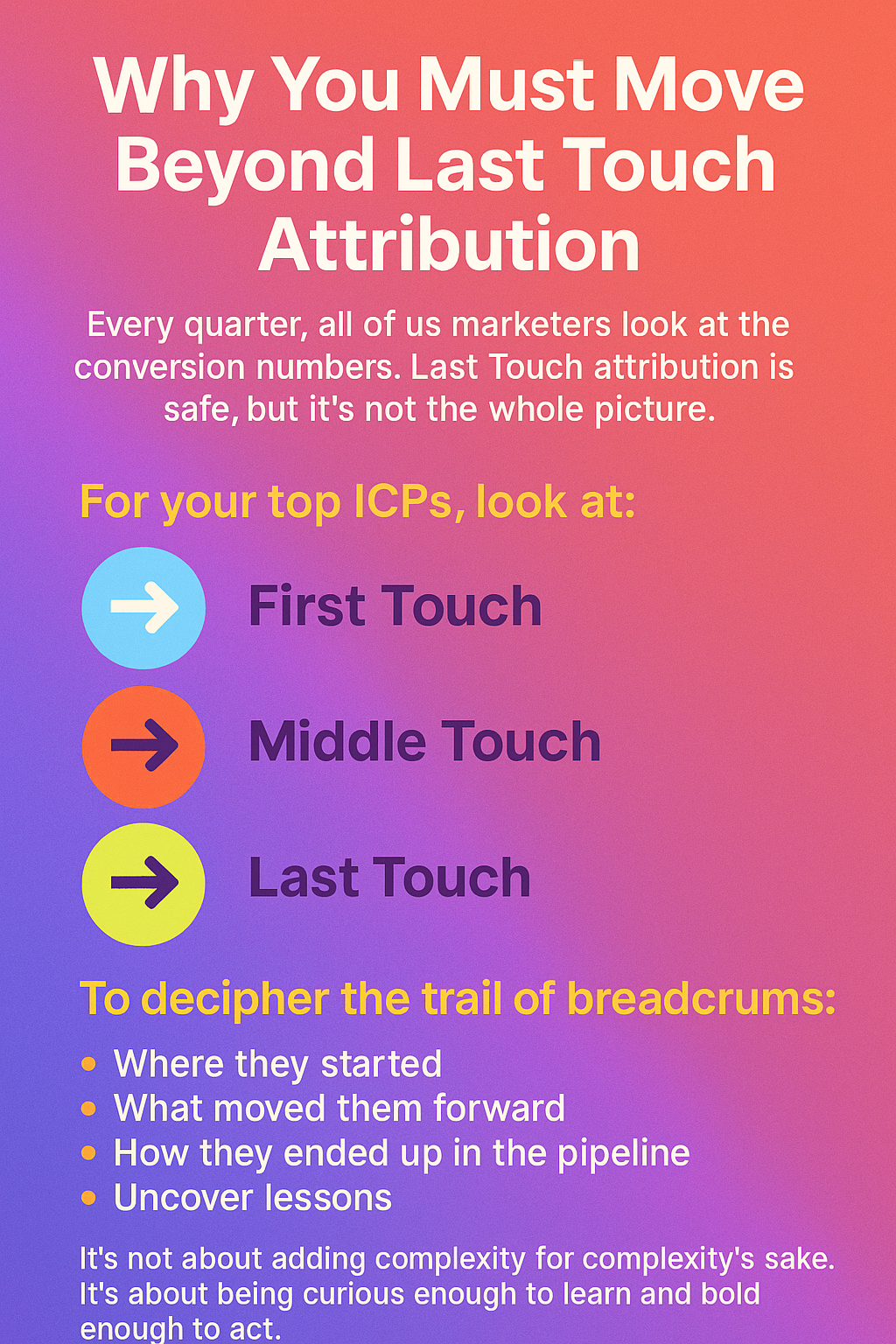Every quarter, marketing teams gather around dashboards and slides.
Conversion numbers are shared. Pipelines are reviewed. Wins are celebrated. Losses are analyzed.
And for most, the underlying model behind these discussions is Last Touch attribution—the conversion credit assigned to the very last interaction before a form fill, signup, or deal.
Last Touch attribution is simple. It is clean. It is easy to report.
It keeps internal peace because it gives clear credit.
But in 2025, brave marketers know: Last Touch attribution alone is not enough.
If you want to understand what is truly moving your best-fit customers, you have to dig deeper.
You have to be willing to map the First, Middle, and Last touchpoints across the full journey.
And that deeper view can unlock insights that drive real growth.
What Is Last Touch Attribution?
Last Touch attribution is a model where 100% of conversion credit is assigned to the very last action a user took before converting.
For example:
- A prospect clicks a retargeting ad and signs up—100% credit goes to the ad.
- A buyer books a demo after visiting a pricing page—100% credit goes to that page.
In reporting, it looks neat and tidy.
But it ignores everything that happened earlier:
The blog post they read two months ago.
The webinar they attended.
The cold email they ignored but remembered later.
The problem is not that Last Touch is wrong—it is that it is incomplete.
Why Last Touch Attribution Remains Popular
There are good reasons Last Touch attribution persists:
- Simplicity: It is easier to pull Last Touch data from most CRMs and marketing automation tools.
- Speed: It allows fast quarterly reporting without complex multi-touch modeling.
- Internal politics: It avoids debates over who “really” deserves credit for a deal.
For basic pipeline analysis, Last Touch can be a useful starting point.
But when you are optimizing budget allocations, refining strategy, or trying to scale more efficiently, it is no longer enough.
Especially for high-value, complex buying journeys.
The Risk of Relying Only on Last Touch Attribution
When you base your decisions solely on Last Touch attribution, you risk:
- Over-investing in bottom-of-funnel channels: Retargeting, brand search, and direct response ads will always look better than they really are.
- Under-valuing top and middle funnel efforts: Podcasts, webinars, whitepapers, and educational content rarely win Last Touch credit—but they are critical to creating demand.
- Misunderstanding true buyer behavior: You miss the story of how buyers found you, engaged with you, and ultimately decided to take action.
In short: Last Touch attribution shows you the final chapter of the story but hides everything that made that ending possible.
Why First, Middle, and Last Touch Matter
Brave marketers ask more curious questions:
Where did the journey start?
What moved the prospect forward?
How did they finally reach the point of conversion?
By mapping the full journey—First Touch, Middle Touch, and Last Touch—you unlock:
- Discovery insights: Which content or channels spark initial awareness among your ICPs?
- Nurture insights: Which touchpoints sustain engagement and trust-building over time?
- Conversion insights: Which final nudges close the loop?
When you see the whole path, you stop optimizing in a vacuum.
You start building marketing programs that respect the true complexity of how buyers make decisions.
How to Start Moving Beyond Last Touch Attribution
You do not have to overhaul your entire analytics system overnight.
Here are practical steps to start blending First, Middle, and Last Touch views:
1. Track First Touch in Your CRM
Capture the very first known interaction (e.g., ad click, event registration, organic blog visit) and store it at the contact level.
This simple step already improves attribution clarity by showing you how prospects discovered you.
2. Implement Multi-Touch Reporting
Use your marketing automation platform, CRM, or attribution tools to build multi-touch reports that show:
- First Touch
- Key Mid-Journey Touches
- Last Touch
You do not need a perfect data model.
Even a directional view reveals new patterns.
3. Run Journey Mapping Exercises
Select 10–20 closed-won deals. Manually map out:
- How did they first hear about you?
- What content or campaigns engaged them along the way?
- What convinced them to take the final step?
Journey mapping humanizes the data and uncovers patterns that pure dashboards miss.
4. Create Insights, Not Ego Battles
When analyzing First, Middle, and Last Touch, the goal is not to assign “credit” to one team or campaign.
The goal is to uncover lessons:
- Which early-stage programs create the right awareness?
- Which mid-stage programs nurture trust?
- Which final-stage programs convert action?
Approach attribution analysis with a spirit of curiosity, not competition.
5. Act Boldly on the Insights You Find
It is not enough to admire the data.
Act on it.
- Double down on the early-stage content that initiates high-quality journeys.
- Refine or remove middle-funnel assets that fail to sustain engagement.
- Strengthen the late-stage assets that close deals faster.
Learning without action is just academic.
Real attribution maturity means changing how you invest based on what you discover.

The Mindset Shift Marketers Need
Moving beyond Last Touch attribution requires two key traits:
- Curiosity: A willingness to ask deeper questions, even when simple answers are tempting.
- Boldness: A readiness to adapt strategy based on what the full journey reveals, not just what the Last Touch dashboard says.
It is not about adding complexity for complexity’s sake.
It is about respecting the real buyer journey enough to learn from it.
And when you do, you stop chasing vanity metrics—and start building a marketing engine truly aligned to how your best customers buy.
Final Thoughts: See the Full Picture, Build Smarter Growth
Last Touch attribution will always have a place.
It provides a fast snapshot. It keeps basic reporting manageable.
But if you want to uncover the true drivers of growth—especially among your highest-value customers—you must be brave enough to dig deeper.
First Touch. Middle Touch. Last Touch.
The full breadcrumb trail tells the real story of your marketing effectiveness.
Be curious enough to see it.
Be bold enough to act on it.
That is how marketing teams move from good to great in 2025 and beyond.

Hi there! I’m Scott, and I am the principal consultant and thought leader behind Stratus Analytics. I have a Master of Science degree in marketing analytics, and I’ve have been providing freelance digital marketing services for over 20 years. Additionally, I have written several books on marketing which you can find here on Amazon or this website.
DISCLAIMER: Due to my work in the packaging industry, I cannot take on freelance clients within the packaging manufacturing space. I do not want to provide disservice to your vision or my employer. Thank you for understanding.
